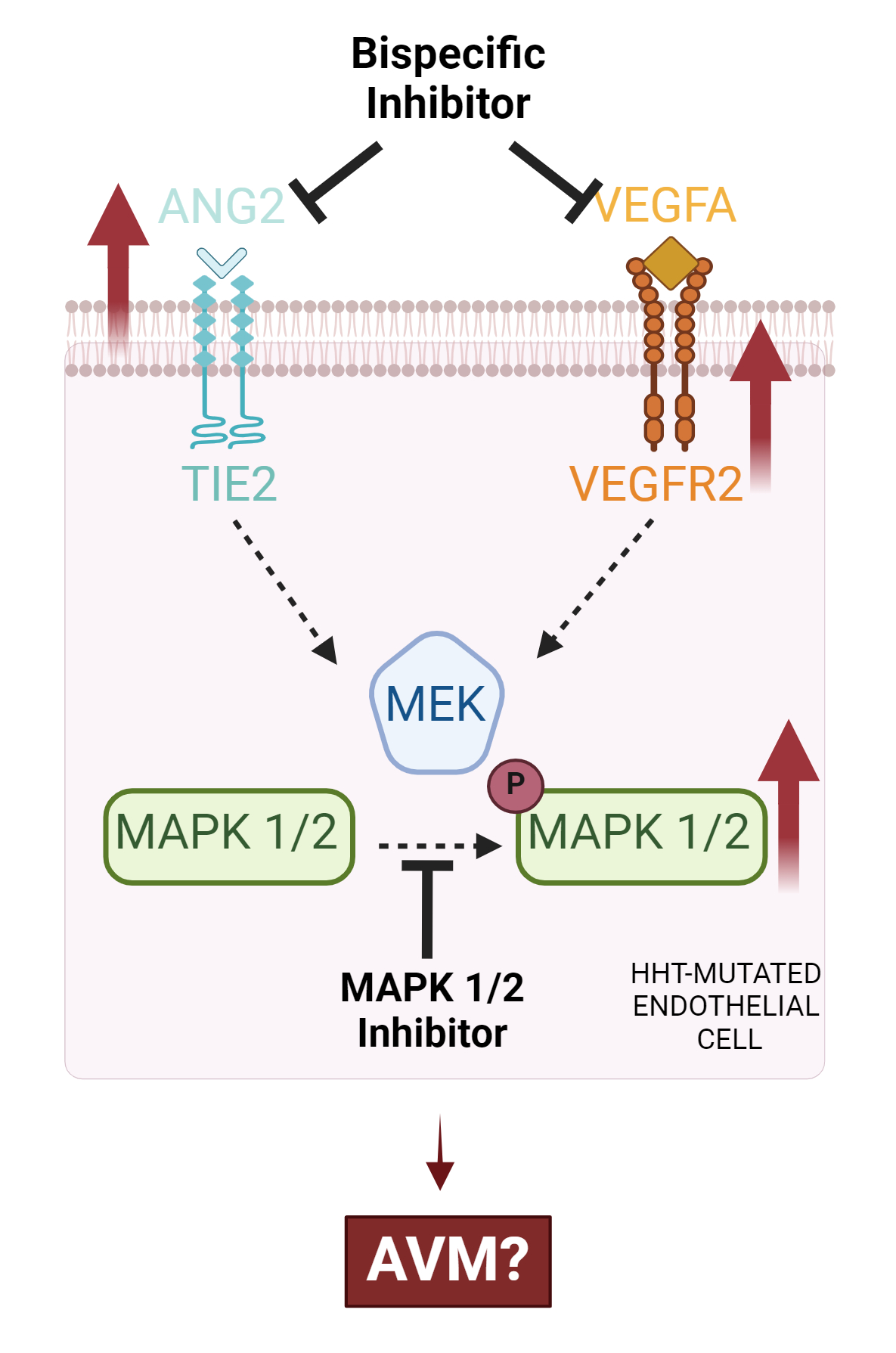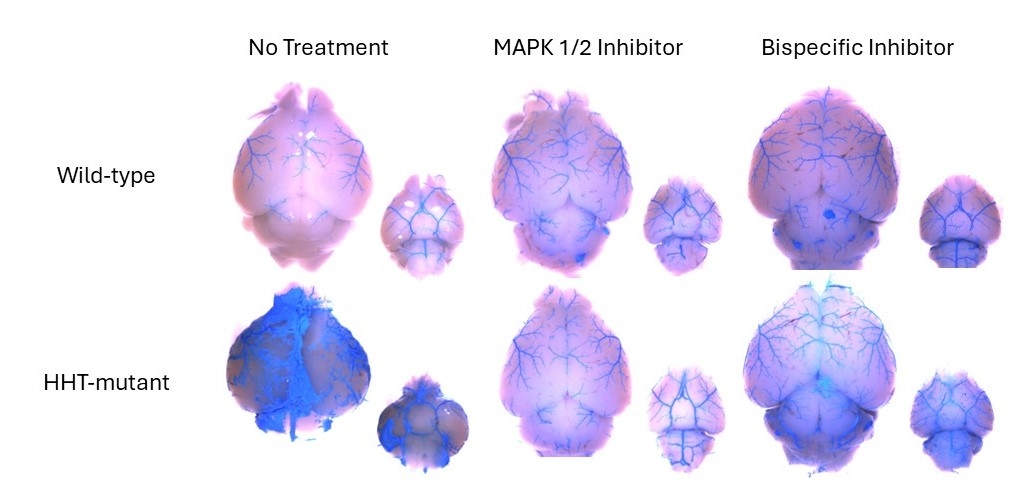Final ID: We098
Target-Specific Novel Therapeutic Approach for Prevention of Arteriovenous Malformations in Hereditary Hemorrhagic Telangiectasia
Abstract Body: Background: Hereditary hemorrhagic telangiectasia (HHT) is a rare genetic vascular disease with no cure. HHT is characterized by abnormalities in blood vessels that occur in mucocutaneous tissues (telangiectasias) and deep tissues (arteriovenous malformations, AVMs). The tangled, enlarged, fragile, and aberrant vasculature in HHT patients is prone to chronic bleeding or hemorrhage and may cause serious complications, especially in the brain.
Problem Statement: While diagnosed AVMs can be surgically treated, there are no FDA-approved drugs to prevent or manage them. Developing targeted therapeutics to manage AVMs has been incredibly challenging as the mechanism of AVM formation is not clearly understood.
Rationale: Dysregulation of pro-angiogenic signaling pathways is considered to play a major role in AVM development. For instance, VEGFA-VEGFR2, ANG2–TIE2 and MAP Kinase 1/2 signaling have been implicated individually in HHT pathogenesis. While MAPK 1/2 signaling is difficult to target because of its universal presence, its upstream activators VEGFA and ANG2 are lucrative targets for their relative specificity primarily affecting vasculature (Figure 1).
Innovation: We use a novel approach to target VEGFA and ANG2 simultaneously using IgG CrossMab bispecific inhibitor, allowing superior efficacy by inhibiting dual specific targets to prevent genetic vasculature abnormalities.
Approach: We use vascular latex casting and molecular quantification techniques to assess the benefits of inhibiting abnormal pro-angiogenic signaling in HHT mice models. Our preliminary data shows improved vasculature development with small doses of MAPK 1/2 inhibitor, but early mortality due to its damaging side effects. Preliminarily, the combined effect of the bispecific inhibitor in smaller doses improves the vasculature defects in the mutant brain more robustly than the individual inhibitors alone, while not negatively affecting the wild-type model (Figure 2). We further expect this dual inhibition to normalize the transcriptomic signature of mutants to mimic the wild-type setting.
Societal Impact: The expected beneficial effects of the bispecific inhibitor will provide a pre-clinical assessment of the cerebrovascular AVM management strategies for 1.4 million HHT patients. It will further the mechanistic understanding of AVM development and prevention in HHT, the 2nd most common bleeding disorder.
Problem Statement: While diagnosed AVMs can be surgically treated, there are no FDA-approved drugs to prevent or manage them. Developing targeted therapeutics to manage AVMs has been incredibly challenging as the mechanism of AVM formation is not clearly understood.
Rationale: Dysregulation of pro-angiogenic signaling pathways is considered to play a major role in AVM development. For instance, VEGFA-VEGFR2, ANG2–TIE2 and MAP Kinase 1/2 signaling have been implicated individually in HHT pathogenesis. While MAPK 1/2 signaling is difficult to target because of its universal presence, its upstream activators VEGFA and ANG2 are lucrative targets for their relative specificity primarily affecting vasculature (Figure 1).
Innovation: We use a novel approach to target VEGFA and ANG2 simultaneously using IgG CrossMab bispecific inhibitor, allowing superior efficacy by inhibiting dual specific targets to prevent genetic vasculature abnormalities.
Approach: We use vascular latex casting and molecular quantification techniques to assess the benefits of inhibiting abnormal pro-angiogenic signaling in HHT mice models. Our preliminary data shows improved vasculature development with small doses of MAPK 1/2 inhibitor, but early mortality due to its damaging side effects. Preliminarily, the combined effect of the bispecific inhibitor in smaller doses improves the vasculature defects in the mutant brain more robustly than the individual inhibitors alone, while not negatively affecting the wild-type model (Figure 2). We further expect this dual inhibition to normalize the transcriptomic signature of mutants to mimic the wild-type setting.
Societal Impact: The expected beneficial effects of the bispecific inhibitor will provide a pre-clinical assessment of the cerebrovascular AVM management strategies for 1.4 million HHT patients. It will further the mechanistic understanding of AVM development and prevention in HHT, the 2nd most common bleeding disorder.
More abstracts on this topic:
Association of ENTPD-1 SNP genotype on inflammatory cell phenotype and ST-elevation myocardial infarction cardiovascular outcomes: a post-hoc analysis of the POPular Genetics
Van Den Broek Wout, Madiai Francesca, Covarrubias Roman, Ten Berg Jurrien, Gumina Richard, Watson Samuel, Bergmeijer Thomas, Azzahhafi Jaouad, Magorien Raymond, Mazzaferri Ernest, Lilly Scott, Attar Talal, Boudoulas Konstantinos
Adipocyte-Derived Small Extracellular Vesicles Enriched with NNMT Inhibit Angiogenesis Post-Myocardial Infarction in DiabetesRen Hang, Cao Liwen, Zhao Zhenkun, Huang Ying, Pan Zhongjing, Cheng Liangfen, Gan Lu


